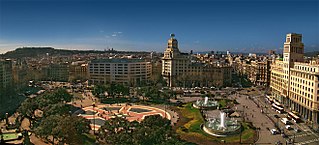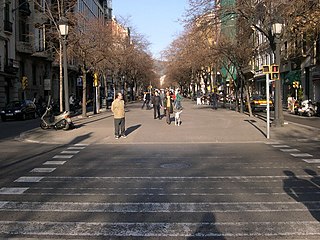
Josep Tarradellas i Joan, 1st Marquess of Tarradellas was a Catalonian politician known for his role as the first president of the Government of Catalonia, after its re-establishment in 1977 under the new Spanish Constitution and the end of the Francoist Dictatorship. He was appointed the role of 125th President of Catalonia in 1954 but spent 23 years in exile until 1977 when he was officially recognised as the President of Catalonia by the Spanish Government.

The Gothic Quarter is the historic centre of the old city of Barcelona. It stretches from La Rambla to Via Laietana, and from the Mediterranean seafront to the Ronda de Sant Pere. It is a part of Ciutat Vella district.

The Palace of the Generalitat of Catalonia is a historic palace in Barcelona, Catalonia, Spain. It houses the offices of the Presidency of the Generalitat de Catalunya. It is one of the few buildings of medieval origin in Europe that still functions as a seat of government and houses the institution that originally built it.

Plaça de Catalunya is a large square in central Barcelona that is generally considered to be both its city centre and the place where the old city and the 19th century-built Eixample meet.

Rambla de Catalunya is a major street in the Eixample district of central Barcelona, Spain. It is one of the city's trendiest streets, with many international fashion shops, and is lined with lime trees.

Plaça d'Espanya is one of Barcelona's most important squares, built on the occasion of the 1929 Barcelona International Exposition, held at the foot of Montjuïc, in the Sants-Montjuïc district.

Plaça de Lesseps is a square serving as the border between the Sarrià-Sant Gervasi and Gràcia district of Barcelona, Catalonia, Spain, loosely divided in two parts. One of the most heavily transited squares in the city, Lesseps is the starting point of one of Barcelona's busiest rondes: Ronda del General Mitre, as well as being the west end of Carrer Gran de Gràcia and being crossed by a number of streets, namely: Travessera de Dalt, Avinguda del Príncep d'Astúries, Avinguda de Vallcarca, Avinguda de la República Argentina, Carrer del Torrent de l'Olla, Carrer de la Mare de Déu del Coll, Carrer de Santa Perpètua, Carrer de Maignon and Carrer de Pérez Galdós.

Plaça de Mossèn Jacint Verdaguer is a square in the Eixample district of Barcelona, Catalonia, Spain. It lies in the intersection between Avinguda Diagonal, the city's main avenue, and Passeig de Sant Joan, in Dreta de l'Eixample, not far from the Sagrada Família.

Josep Llimona i Bruguera was a Spanish sculptor. His first works were academic, but after a stay in Paris, influenced by Auguste Rodin, his style drew closer to modernisme. He was very prolific, and exhibited in Catalonia, Madrid, Paris, Brussels and Buenos Aires. Some of his monumental work is familiar to Barcelona residents and visitors alke.

The 1929 Barcelona International Exposition was the second World Fair to be held in Barcelona, the first one being in 1888. It took place from 20 May 1929 to 15 January 1930 in Barcelona, Spain. It was held on Montjuïc, the hill overlooking the harbor, southwest of the city center, and covered an area of 118 hectares at an estimated cost of 130 million pesetas. Twenty European nations participated in the fair, including Germany, Britain, Belgium, Denmark, France, Hungary, Italy, Norway, Romania and Switzerland. In addition, private organizations from the United States and Japan participated. Hispanic American countries as well as Brazil, Portugal and the United States were represented in the Ibero-American section in Sevilla.

The Parc de la Ciutadella is a park on the northeastern edge of Ciutat Vella, Barcelona, Catalonia, Spain. For decades following its creation in the mid-19th century, this park was the city's only green space. The 31 hectares grounds include the city zoo, the Palau del Parlament de Catalunya, a small lake, museums, and a large fountain designed by Josep Fontserè.

Plaça de Tetuan, known in Spanish as Plaza de Tetuán, is a major square in Barcelona. It is in Fort Pienc, in the central district of Eixample, at the busy intersection of Gran Via de les Corts Catalanes and Passeig de Sant Joan. The square is named after the 1860 Battle of Tétouan, the siege and occupation of the Moroccan city of Tetuan by general Joan Prim and Catalan volunteers. It was formerly called Hermenegildo Giner de los Ríos.
Antoni Vila Arrufat (1894–1989) was a Spanish engraver from Sabadell in Catalonia.

Public art in Barcelona is a designated group of monuments and outdoor sculptures in the city. The artworks in city's architecture and network of museums, parks, and gardens, put an artistic stamp on the Catalan capital. Public art in the city developed in the 19th century, although the first municipal commission was the 1673 monument to Saint Eulalia in Pedró Square.

The following outline is provided as an overview of and topical guide to Barcelona:

The odonyms of Barcelona — meaning the street names in Barcelona along with the names of thoroughfares and other roads in the city — are regulated by the Ponència de Nomenclàtor dels Carrers de Barcelona, a commission under the Department of Culture of the Barcelona City Council.

The set of sculptures in the Plaça de Catalunya was created between 1927 and 1929 for the 1929 Barcelona International Exposition. The Catalonia Square is one of the main centers of Barcelona, and is located in the Eixample district, at the confluence between the Rambla de Canaletas, the carrer de Pelai, the ronda de la Universitat, the Rambla de Catalunya, Passeig de Gràcia, Ronda de Sant Pere, Fontanella street and Portal de l'Àngel. It has an area of 5 hectares.



































































